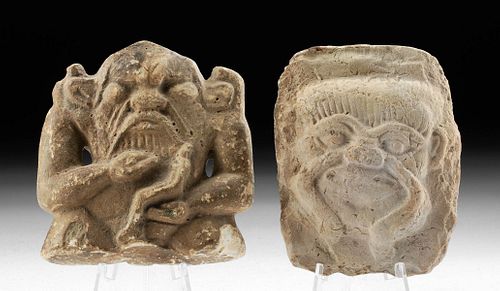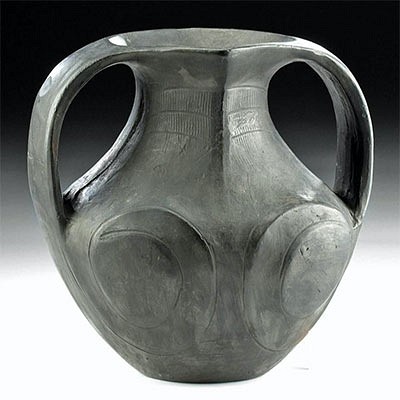2 Pottery Figures of Deities - Mesopotamian & Egyptian
Lot 10
About Seller
Artemis Fine Arts
686 S Taylor Ave, Ste 106
Louisville, CO 80027
United States
Selling antiquities, ancient and ethnographic art online since 1993, Artemis Gallery specializes in Classical Antiquities (Egyptian, Greek, Roman, Near Eastern), Asian, Pre-Columbian, African / Tribal / Oceanographic art. Our extensive inventory includes pottery, stone, metal, wood, glass and textil...Read more
Estimate:
$1,200 - $1,800
Absentee vs Live bid
Two ways to bid:
- Leave a max absentee bid and the platform will bid on your behalf up to your maximum bid during the live auction.
- Bid live during the auction and your bids will be submitted real-time to the auctioneer.
Bid Increments
| Price | Bid Increment |
|---|---|
| $0 | $25 |
| $300 | $50 |
| $1,000 | $100 |
| $2,000 | $250 |
| $5,000 | $500 |
| $10,000 | $1,000 |
| $20,000 | $2,500 |
| $50,000 | $5,000 |
| $100,000 | $10,000 |
| $200,000 | $20,000 |
About Auction
By Artemis Fine Arts
Dec 16, 2021
Set Reminder
2021-12-16 10:00:00
2021-12-16 10:00:00
America/New_York
Bidsquare
Bidsquare : VARIETY SALE | Antiquities & Ethnographic Art
https://www.bidsquare.com/auctions/artemis-gallery/variety-sale-antiquities-ethnographic-art-8026
Featuring classical antiquities, ancient and ethnographic art from cultures encompassing the globe. Egyptian, Greek, Roman, Etruscan, Near Eastern, Asian, Pre-Columbian, Native American, African / Tribal, Oceanic, Spanish Colonial, Russian, Fossils, Fine Art, more! Artemis Fine Arts info@artemisgallery.com
Featuring classical antiquities, ancient and ethnographic art from cultures encompassing the globe. Egyptian, Greek, Roman, Etruscan, Near Eastern, Asian, Pre-Columbian, Native American, African / Tribal, Oceanic, Spanish Colonial, Russian, Fossils, Fine Art, more! Artemis Fine Arts info@artemisgallery.com
- Lot Description
Ancient Near East, Mesopotamia, ca. late 3rd to 2nd millennium BCE; Egypt, Late Dynastic Period, 26th to 31st Dynasty, ca. 664 to 332 BCE. A wonderful pair of pottery depictions of deities: 1 Mesopotamian relief of the head of the demon giant Humbaba and 1 Egyptian flat figure of the dwarf god Bes shown seated. First, the Mesopotamian relief is of rectangular form and displays a square, intimidating visage with large, almond-shaped eyes beneath an arched brow, a bulbous nose, a long moustache, full lips, and gritted teeth, all between a pair of high-set ears and capped by a helmet-like coiffure. Alternatively, the Egyptian figure of Bes is shown full-bodied and kneeling as he holds an infant in his bent left arm and motions toward the child with his right hand. The squat deity presents a huge head with a straight brow, bulging eyes, a wide nose, and full lips engulfed in a lengthy moustache and striated beard, all flanked by a pair of pointed ears. Size (of largest): 3.1" W x 3.1" H (7.9 cm x 7.9 cm)
His upturned feet, slender tail, and long coiffure or headdress can be seen on the verso.
In Akkadian mythology, Humbaba or Huwawa was a monstrous demon giant who personified Styx, the river of the dead. Humbaba was also the guardian of the Forest of the Cedars where the other gods resided. The most famous Mesopotamian story - entitled "The Epic of Gilgamesh" - narrates how Gilgamesh and Enkidu set out on an adventure to the Cedar Forest to slay Humbaba. Once they find Humbaba, the giant demon renowned for his terrifying, supernatural radiance, they beat him nearly to death. Humbaba's pleas for mercy were almost granted, however Enkidu convinces Gilgamesh to finally kill the beast and achieve global fame for the rest of time; subsequently, Gilgamesh acquiesces to his friend's suggestion and beheads the dreaded monster. The severed head of Humbaba was then affixed to a cedar door and sent to the temple of Enlil, king of the gods. This literary detail may explain the abundance of clay plaques depicting Humbaba's wrinkled and terrifying face as they were perhaps primarily used as charms against evil and may have been hung on entrances to homes or businesses.
Alternatively, Bes, the bandy-legged leonine dwarf god, was an apotropaic deity, who protected the home, children, and women in pregnancy and childbirth. In his role as protector of the home, he was thought to dispel bad dreams, as well as increase virility in men and fertility in women, which also associated him with fecundity. An Egyptian god, Bes not only continued to be a popularly depicted deity well into the Graeco-Roman Period, but representations of him also became widespread across the Near East during the first millennium BCE. In Mesopotamia, however, he was viewed as more of an apotropaic creature than a deity proper.
Provenance: East Coast collection, New York Gallery, New York City, New York, USA, acquired before 2010
All items legal to buy/sell under U.S. Statute covering cultural patrimony Code 2600, CHAPTER 14, and are guaranteed to be as described or your money back.
A Certificate of Authenticity will accompany all winning bids.
PLEASE NOTE: Due to recent increases of shipments being seized by Australian & German customs (even for items with pre-UNESCO provenance), we will no longer ship most antiquities and ancient Chinese art to Australia & Germany. For categories of items that are acceptable to ship to Australia or Germany, please contact us directly or work with your local customs brokerage firm.
Display stands not described as included/custom in the item description are for photography purposes only and will not be included with the item upon shipping.
#146078Egyptian figure has repair to head, as well as losses to top of head and chips to base. Chips to periphery of Mesopotamian figure. Both have expected nicks and abrasions, commensurate with age. Otherwise, both are very nice with impressive remaining details. Collection number inscribed on verso of Egyptian figure near base.Condition
- Shipping Info
-
All shipping is handled in-house for your convenience. Your invoice from Artemis Gallery will include shipping calculation instructions. If in doubt, please inquire BEFORE bidding for estimated shipping costs for individual items.
-
- Buyer's Premium



 EUR
EUR CAD
CAD AUD
AUD GBP
GBP MXN
MXN HKD
HKD CNY
CNY MYR
MYR SEK
SEK SGD
SGD CHF
CHF THB
THB













